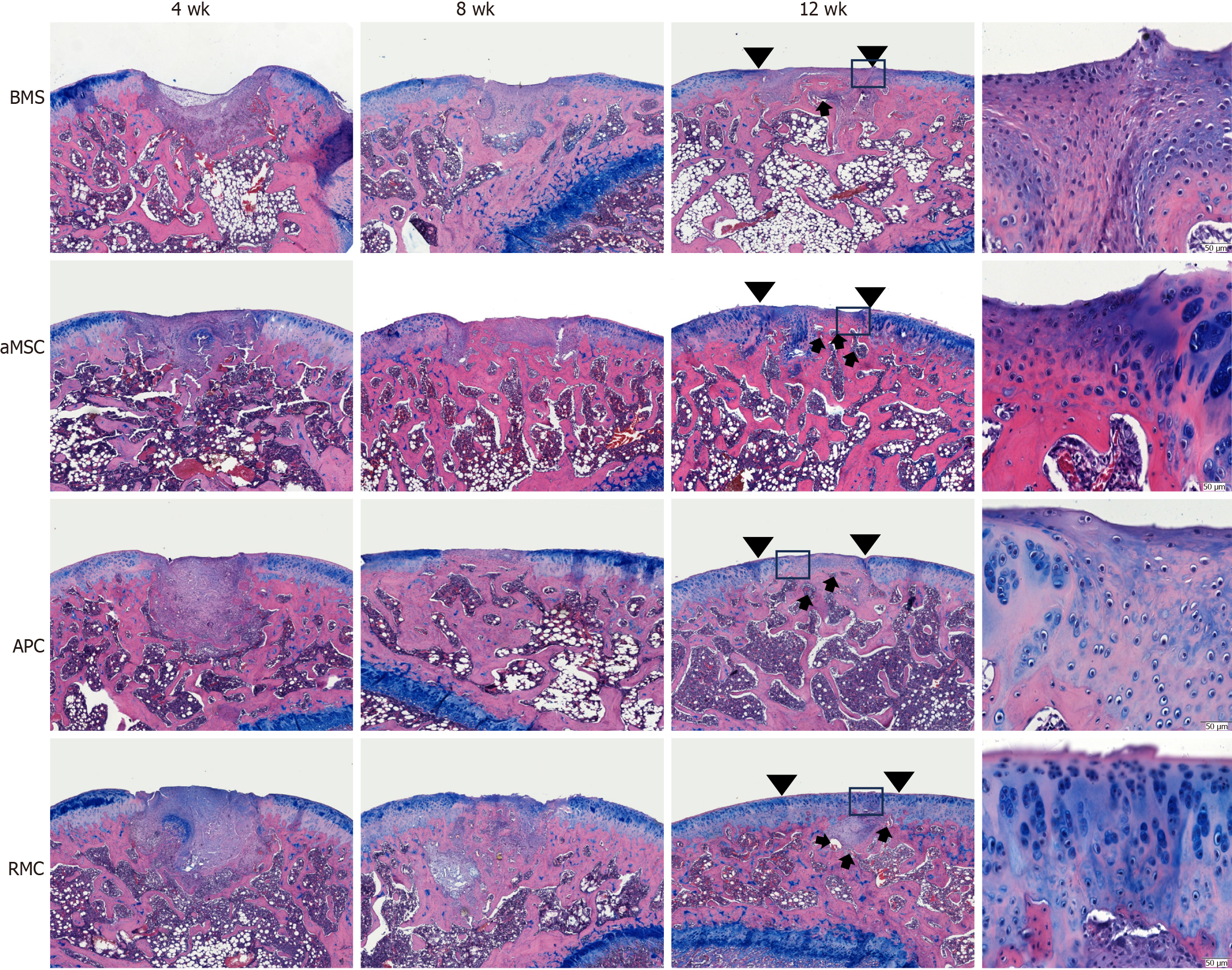Copyright
©The Author(s) 2024.
World J Stem Cells. Feb 26, 2024; 16(2): 176-190
Published online Feb 26, 2024. doi: 10.4252/wjsc.v16.i2.176
Published online Feb 26, 2024. doi: 10.4252/wjsc.v16.i2.176
Figure 4 Histological evaluation using counter-staining of hematoxylin and eosin and alcian blue for osteochondral defect repair by applying different extracellular matrix-sheets at 4, 8 and 12 wk.
Insets are the enlarged area for more detailed evaluation of critical sites at week 12. Note that, consistent with the morphological evaluation, histologically at week 4, the defects in the bone marrow stimulation (BMS) group had only started to be filled with fibrous tissue, whereas those of the other three groups were fully filled with the regenerated tissue. The filled tissue in antler reserve mesenchymal cell (RMC) group was stained bluer (proteoglycan) by alcian blue, indicating that the tissue was more cartilage in nature. At week 8, the repair process had almost reached completion except for the BMS group, although the regenerated tissue varied in type among the different groups. In the BMS group, fibrous tissue with negligible osseous tissue was formed; in the adipocyte-derived mesenchymal stromal cell (aMSC) group, osseous tissue with a rough surface and with negligible fibrous tissue was formed; in the antlerogenic periosteal cell (APC) group, only osseous tissue with a smooth surface had formed; in the RMC group, osteocartilaginous tissue was detected with cartilage tissue evident on the outermost surface. At week 12, the repair process was essentially complete, although the quality of the repair varied greatly among the groups. In the BMS group, a mixture of osseous and fibrous tissue in the defect (arrowheads) was formed with the fibrous tissue replacing the cartilage as a surface layer (inset); in both the aMSC and APC groups, the reconstructed cartilage layer (arrowheads; fibrous in nature) was not as thick as the original, and resident chondrocytes were randomly distributed (inset), although the APC group had a smoother surface than aMSC group; in the RMC group, the osteochondral defect was perfectly repaired with a well-reconstructed smooth-surfaced outermost layer of cartilage (arrowheads; hyaline in nature), and the resident chondrocytes were arranged in a stacked style, typical of articular cartilage, see inset). Bar = 500 μm. BMS: Bone marrow stimulation; aMSC: Adipocyte-derived mesenchymal stromal cell; APC: Antlerogenic periosteal cell; RMC: Antler reserve mesenchymal cell.
- Citation: Wang YS, Chu WH, Zhai JJ, Wang WY, He ZM, Zhao QM, Li CY. High quality repair of osteochondral defects in rats using the extracellular matrix of antler stem cells. World J Stem Cells 2024; 16(2): 176-190
- URL: https://www.wjgnet.com/1948-0210/full/v16/i2/176.htm
- DOI: https://dx.doi.org/10.4252/wjsc.v16.i2.176









